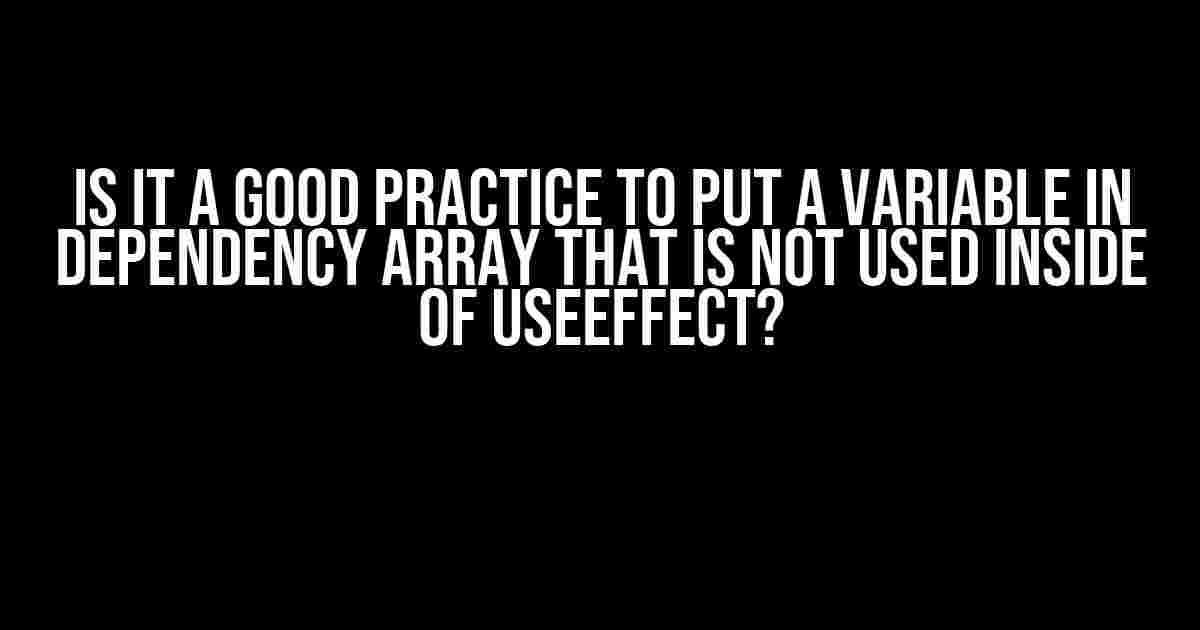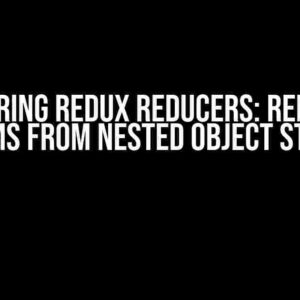Have you ever wondered whether it’s a good idea to include a variable in the dependency array of a `useEffect` hook, even if it’s not used inside the effect itself? If so, you’re not alone! This question has sparked a lot of debate in the React community, and today we’re going to dive into the details to provide a clear answer.
The Basics of useEffect and Dependency Arrays
import { useState, useEffect } from 'react';
function Example() {
const [count, setCount] = useState(0);
useEffect(() => {
document.title = `You clicked ${count} times`;
}, [count]); // <--- dependency array
return (
You clicked {count} times
);
}
In the above example, the `useEffect` hook updates the document title whenever the `count` state changes. This is achieved by including `count` in the dependency array. When `count` changes, the effect is re-run with the new value.
The Question: Should You Include Unused Variables in the Dependency Array?
Now, let’s say you have a variable `unusedVariable` that is not used inside the effect, but you still want to include it in the dependency array. Is it a good practice to do so?
import { useState, useEffect } from 'react';
function Example() {
const [count, setCount] = useState(0);
const unusedVariable = 42; // unused variable
useEffect(() => {
document.title = `You clicked ${count} times`;
}, [count, unusedVariable]); // <--- including unusedVariable in dependency array
return (
You clicked {count} times
);
}
Arguments For and Against Including Unused Variables
There are valid arguments both for and against including unused variables in the dependency array. Let’s explore them:
Arguments For Including Unused Variables
- Consistency**: Including unused variables in the dependency array ensures that the effect is re-run whenever any dependency changes, even if it’s not used inside the effect. This can be helpful in certain scenarios where you want to ensure that the effect is always up-to-date, even if it doesn’t directly depend on the variable.
- Simplification**: Including unused variables can simplify your code by avoiding the need to manually track dependencies. If you’re unsure about whether a variable is used inside the effect, it’s easier to just include it in the dependency array to be safe.
Arguments Against Including Unused Variables
- Performance**: Including unused variables can lead to unnecessary re-renders of the component, which can negatively impact performance. If the unused variable changes frequently, this can cause the effect to re-run unnecessarily, wasting resources.
- Code Readability**: Including unused variables can make the code less readable, as it’s not clear why the variable is included in the dependency array. This can lead to confusion and make it harder to maintain the codebase.
- Best Practices**: Including unused variables goes against the principle of least surprise. It’s generally expected that the dependency array only includes variables that are actually used inside the effect.
Conclusion: Best Practices for Including Variables in Dependency Arrays
So, what’s the verdict? Should you include unused variables in the dependency array? The answer is a resounding **no**. Here are some best practices to follow:
- Only include variables that are actually used inside the effect**. This ensures that the dependency array is concise and only includes variables that are necessary for the effect to function correctly.
- Avoid including variables that are not used inside the effect**. This helps maintain code readability and avoids unnecessary re-renders of the component.
- Use the dependency array to declare the effect’s dependencies**, not to include arbitrary variables. This helps keep your code organized and easy to maintain.
| Scenario | Include in Dependency Array? |
|---|---|
| Variable is used inside the effect | Yes |
| Variable is not used inside the effect, but you want to ensure the effect re-runs when it changes | No (instead, consider using a separate effect or refactoring your code to avoid the unnecessary dependency) |
| Variable is not used inside the effect and you’re unsure whether to include it | No (if in doubt, exclude it to maintain code readability and performance) |
By following these best practices, you’ll be able to write more efficient, readable, and maintainable code that avoids unnecessary re-renders and confusion.
Final Thoughts
In conclusion, including unused variables in the dependency array is not a good practice. Instead, focus on only including variables that are actually used inside the effect, and use the dependency array to declare the effect’s dependencies. By following this approach, you’ll be able to write more efficient, readable, and maintainable code that takes advantage of the power of `useEffect` hooks.
If you have any further questions or concerns, feel free to reach out in the comments below! And remember to always keep your code concise, readable, and efficient.
References
For more information on `useEffect` and dependency arrays, be sure to check out the official React documentation:
We hope you found this article informative and helpful! Remember to share your thoughts and feedback in the comments below.
Frequently Asked Question
Get the lowdown on the age-old debate: should you put variables in the dependency array that aren’t used inside of useEffect?
Is it a good practice to put a variable in the dependency array even if it’s not used inside of useEffect?
Absolutely not! Including unnecessary variables in the dependency array can lead to unnecessary re-renders, which can negatively impact performance. Only include variables that are actually used inside the effect to avoid unnecessary re-renders.
What happens if I include a variable in the dependency array that’s not used inside of useEffect?
When the variable changes, the effect will re-run, even if it’s not actually used inside the effect. This can lead to unexpected behavior, infinite loops, or even crashes. So, be cautious and only include variables that are actually used inside the effect!
Why does including unnecessary variables in the dependency array cause performance issues?
When the dependency array includes unnecessary variables, the effect will re-run whenever any of those variables change. This can lead to a cascade of unnecessary re-renders, which can slow down your app and even cause errors. By only including necessary variables, you can prevent unnecessary re-renders and keep your app running smoothly.
Can I include a variable in the dependency array if I plan to use it in a future update?
Hold up, partner! While it might seem convenient to include a variable in the dependency array “just in case,” it’s better to wait until you actually use it inside the effect. Including unnecessary variables can lead to performance issues, and it’s easier to add them when you actually need them.
How can I avoid including unnecessary variables in the dependency array?
Simple! Whenever you write an effect, take a step back and think about which variables are actually used inside the effect. Only include those variables in the dependency array, and you’ll be golden! If you’re unsure, try removing variables one by one to see which ones actually trigger the effect.




